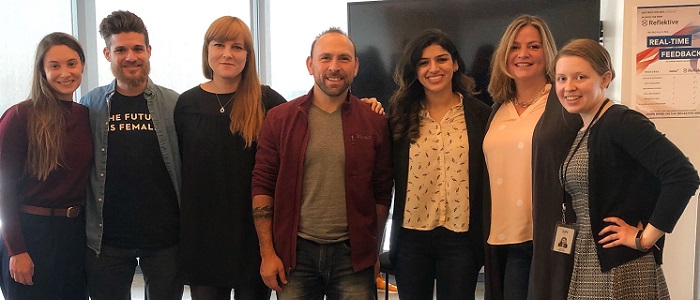In a meeting with Joe Z this week at the IAB Annual Leadership Meeting (ALM) in Phoenix, Arizona, one of our partners dated our relationship by saying, “Seven IABs ago…” It was said with humor, but the fact also communicates the importance of this particular gathering of the IAB and its members to our community. We date our progress and relationships to some degree by the passing of the conferences—and in an industry that moves at lightning speed, that’s saying something.
The IAB ALM was more than an opportunity for marathon meetings. First, it was a chance to recognize some of the great work being done in the industry, including here at MediaMath. Our peers commended our leadership across four areas:
- A Service Excellence Award to Floriana Nicastro, Director, Mobile Product Strategy, for helping IAB establish a common framework for “5 Questions to Evaluate Your Identity Partners”
- A Tech Lab Service Excellence Award to Charlie Simon, Director, Data Policy and Governance, for his work on the GDPR Commit Group
- An Education Excellence Award to the New Marketing Institute
- An Award for Overall Sales Excellence for a Small-to-Medium Sales Organization
It was like being Lady Gaga at the Grammys (which happened to be trending on Twitter at the same time we were live-tweeting the #IABALM opening).
But beyond the accolades, for which we were very humbled, we learned and grew ourselves. Conference speakers communicated the important message that we are in a new age of disruption on three fronts. First, direct-to-consumer (DTC) brands have come of age and are disrupting the markets in which they compete as well as the way in which businesses use data. Second, marketers are demanding to get and know more from the advertising and marketing technology that connects them to consumers. Third, privacy is no longer an issue for the legal department, it is an existential challenge that demands the ecosystem’s full attention.
DTC disruption
The main stage at the conference opened with IAB CEO Randall Rothenberg delivering a flawless and well-constructed presentation of the disruptors among us (check out the IAB 250 Report to discover the most important disruptor consumer brands in U.S. economy). He highlighted that DTC brands are growing in ways that outpace incumbents in their market and doing it using data and digital platforms as well as traditional physical infrastructure and linear television. For the programmatic world, these companies are relatively new to the scene, largely dependent on Facebook because it is easy and it is what they know, but they are seeking alternatives and seeing the benefits of trying out different digital paths to consumers. Over time, we believe they will become key demand-side actors in the space, and we aim to serve them.
After Randall’s speech, he welcomed to the stage the founders of the wildly successful DTC brand ThirdLove. Their presentation was interesting because of how data-enriched their service is and the story they tell about how ThirdLove came to be. First the data. It tells you things that are at first counter-intuitive. The brand’s primary customer is not in cities, and it’s not all millennials. The feedback from consumers drives the brand’s product development and sheds light on things ranging from the need for different color undergarments to reflect different skin tones to the importance of women over age 30 seeing themselves reflected in marketing.
For those of us from MediaMath in the audience, we saw a kindred spirit in the young DTC company. It is up against much larger competitors, taking risks, working as a force for good using its product to help women and girls around the world, and investing and reinvesting in its technology as a tool for driving value for customers and employees.
From digital video to digital identity
MediaMath also participated in two important panels at the conference. Mike Fisher, our passionate advocate for all things sight, sound, and motion, participated in a town hall with SpotX, CBS Interactive, Hulu and Sony Crackle about the future of connected TV and digital video. He broke down the need to address digital and linear differently: “Video is video, but getting the right video creative and using the right screen for the right message is what you have to do…screen size matters and engagement matters.”
While Mike was in one ballroom, Danny Sepulveda was in another communicating our passionate commitment to doing right by consumers and the ecosystem when it comes to privacy. Joined by luminaries in the business John Montgomery from Group M, Townsend Feehan from IAB Europe and Doug Miller from Verizon, the group agreed that the business needs to plan for the new California privacy law as if it will go into effect without changes while respectfully advocating for reasonable amendments to the law for the good of the ecosystem as a whole. The panel was ably moderated by the IAB’s man in Washington and an old friend of MediaMath’s David Grimaldi. The other message that the panel delivered was that the ecosystem needs to invest in, rally around and present a better way to design law that does right by consumers without distorting the data-driven economy in favor of one business model or at the cost of creating barriers to independent ad tech’s existence.
Where to from here
No single part of the ecosystem is independent from the others. We work to serve each other—publishers, marketers, agencies and tech providers alike—and when we do it well, information is not hoarded or trapped inside a garden—it is distributed and shared with respect for consumer privacy to serve their market needs. We at MediaMath are committed to that value exchange and are working hard to deliver it within the construct of a mature, responsive and respectful tech stack.
We also know that education plays a critical role in moving the industry forward. It’s fitting that NMI just celebrated its seventh birthday (seems to be our lucky number). Having had an opportunity to connect with industry colleagues and friends during the conference, there seemed to be shared enthusiasm for our commitment to education and the acknowledgment that this industry is complex and fast-moving. Creating a safe space in which to have bold conversations, recognizing where the learning gaps exist and designing a structured educational framework that drives adoption of new technologies and digital transformation are critical components.
Seven IABs from today, we will still be there, having constructed a digital path to consumers that is simple, scaled and accessible to brands, from those with pop-up stores and a quality product of any size to publishers with engaging platforms on which to reach consumers.
About Lauren Fritsky
 Lauren is the Senior Director of Content at MediaMath, responsible for creating, executing against and managing the global, data-driven content strategy that informs key themes and messaging across paid, owned and earned. A native of the Jersey Shore, Lauren graduated from La Salle University in Philadelphia with an English degree that she has put to use as a print journalist, trade magazine editor, professional blogger and now content marketer. After a 3.5-year stint in Sydney, Australia and a 4.5-year stint in New York City, Lauren now lives in Phoenix with her husband and two children. She loves to travel, read true crime books and eat all the dark chocolate.
Lauren is the Senior Director of Content at MediaMath, responsible for creating, executing against and managing the global, data-driven content strategy that informs key themes and messaging across paid, owned and earned. A native of the Jersey Shore, Lauren graduated from La Salle University in Philadelphia with an English degree that she has put to use as a print journalist, trade magazine editor, professional blogger and now content marketer. After a 3.5-year stint in Sydney, Australia and a 4.5-year stint in New York City, Lauren now lives in Phoenix with her husband and two children. She loves to travel, read true crime books and eat all the dark chocolate.
About Daniel Sepulveda
 As VP for Global Government Relations, Danny Sepulveda joined MediaMath after spending two decades in public service, including work at the highest levels of the US government. In the Obama administration, Danny served as Ambassador and Deputy Assistant Secretary in the U.S. State Department under Secretary of State John Kerry, where he traveled the world working on high-level initiatives including cyber policy, digital economy, internet governance and human rights. Prior to that, he worked as a senior aide to three US Senators, including then Senators Barack Obama and John Kerry. Danny’s role at MediaMath is focused on shaping, implementing and communicating MediaMath’s policies and practices around the consumer value proposition, privacy protection and public policy.
As VP for Global Government Relations, Danny Sepulveda joined MediaMath after spending two decades in public service, including work at the highest levels of the US government. In the Obama administration, Danny served as Ambassador and Deputy Assistant Secretary in the U.S. State Department under Secretary of State John Kerry, where he traveled the world working on high-level initiatives including cyber policy, digital economy, internet governance and human rights. Prior to that, he worked as a senior aide to three US Senators, including then Senators Barack Obama and John Kerry. Danny’s role at MediaMath is focused on shaping, implementing and communicating MediaMath’s policies and practices around the consumer value proposition, privacy protection and public policy.











 Lauren is the Senior Director of Content at MediaMath, responsible for creating, executing against and managing the global, data-driven content strategy that informs key themes and messaging across paid, owned and earned. A native of the Jersey Shore, Lauren graduated from La Salle University in Philadelphia with an English degree that she has put to use as a print journalist, trade magazine editor, professional blogger and now content marketer. After a 3.5-year stint in Sydney, Australia and a 4.5-year stint in New York City, Lauren now lives in Phoenix with her husband and two children. She loves to travel, read true crime books and eat all the dark chocolate.
Lauren is the Senior Director of Content at MediaMath, responsible for creating, executing against and managing the global, data-driven content strategy that informs key themes and messaging across paid, owned and earned. A native of the Jersey Shore, Lauren graduated from La Salle University in Philadelphia with an English degree that she has put to use as a print journalist, trade magazine editor, professional blogger and now content marketer. After a 3.5-year stint in Sydney, Australia and a 4.5-year stint in New York City, Lauren now lives in Phoenix with her husband and two children. She loves to travel, read true crime books and eat all the dark chocolate. As VP for Global Government Relations, Danny Sepulveda joined MediaMath after spending two decades in public service, including work at the highest levels of the US government. In the Obama administration, Danny served as Ambassador and Deputy Assistant Secretary in the U.S. State Department under Secretary of State John Kerry, where he traveled the world working on high-level initiatives including cyber policy, digital economy, internet governance and human rights. Prior to that, he worked as a senior aide to three US Senators, including then Senators Barack Obama and John Kerry. Danny’s role at MediaMath is focused on shaping, implementing and communicating MediaMath’s policies and practices around the consumer value proposition, privacy protection and public policy.
As VP for Global Government Relations, Danny Sepulveda joined MediaMath after spending two decades in public service, including work at the highest levels of the US government. In the Obama administration, Danny served as Ambassador and Deputy Assistant Secretary in the U.S. State Department under Secretary of State John Kerry, where he traveled the world working on high-level initiatives including cyber policy, digital economy, internet governance and human rights. Prior to that, he worked as a senior aide to three US Senators, including then Senators Barack Obama and John Kerry. Danny’s role at MediaMath is focused on shaping, implementing and communicating MediaMath’s policies and practices around the consumer value proposition, privacy protection and public policy.